
Explore Traditional Craft Villages in Hanoi – Discover Hanoi’s Cultural Heritage
Explore the traditional craft villages of Hanoi to uncover the city’s deep cultural heritage. These villages—like Hang Be, Hang Dao, and Hang Gai—offer a glimpse into the artisanal traditions and craftsmanship that have shaped the city’s identity. From pottery and silk weaving to bamboo handicrafts and water puppetry, each village reflects the essence of Vietnamese culture. A visit to these villages not only reveals the skills of local artisans but also provides an opportunity to experience Hanoi’s history and charm beyond the well-known tourist attractions.
Top Famous Craft Villages in Hanoi
1. Thach Xa Bamboo Dragonfly-Making Village
- Location: Approximately 25 km from Hanoi, situated at the foot of Tay Phuong Mountain in Thach Xa commune, Thach That district, Hanoi
- Transportation: From Hanoi, travelers can go to Gia Lam Bus Station or Giap Bat Bus Station and take a bus to Yen Nghia Bus Station. Then, continue with another bus to Son Tay, asking the driver to stop near Tay Phuong Pagoda. From the main road, it’s a 500m walk along the village road to reach the destination. Additionally, if you wish to find a fast and convenient means of transportation with door-to-door service.
Bamboo has long been a cherished symbol of Vietnam’s northern countryside, embodying resilience, simplicity, and a deep connection to rural life. In traditional villages, bamboo hedges not only marked village boundaries but also held countless memories for children who grew up surrounded by their quiet charm.
From the simple houses of Thach Xa commune, Thach That district, Hanoi, traditional artisans with skilled hands, diligence, and creativity have crafted unique bamboo dragonflies that can perch anywhere due to the principle of gravitational balance.
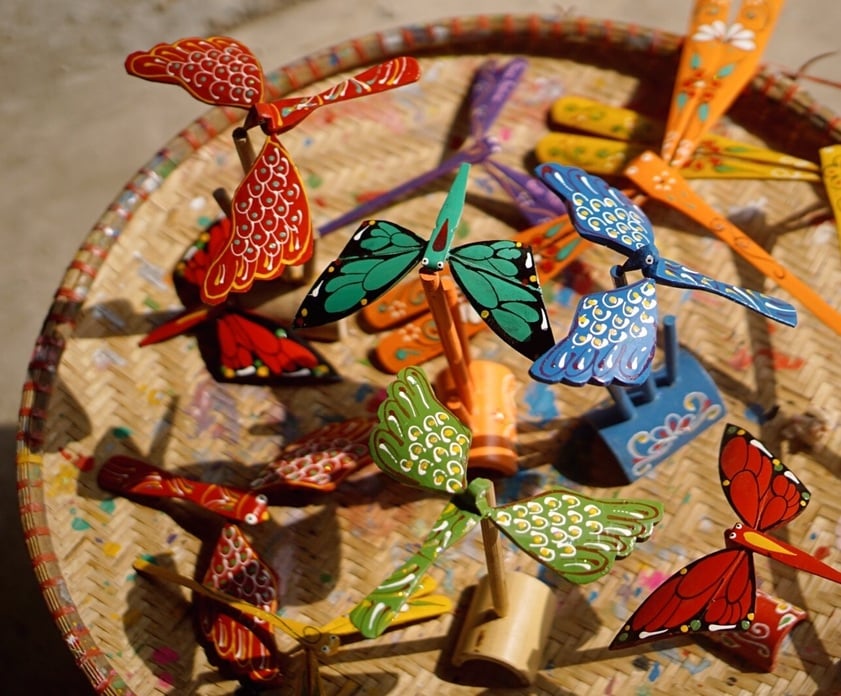
Dragonflies, often referred to by scientists as “aerial assassins” or “stealth fighters,” are renowned for their exceptional flying skills and 360-degree vision. These fascinating abilities have inspired technological innovations and led to the establishment of conservation areas worldwide, acknowledging the invaluable contributions dragonflies bring to humanity.
In Phung Xa Commune, traditional artisans have drawn inspiration from these remarkable insects to create bamboo dragonflies—simple yet captivating works of art. These dragonflies are not only visually charming but also possess a unique ability to balance effortlessly on any surface, showcasing both the ingenuity and dedication of their creators.
Crafted with patience and precision, each bamboo dragonfly reflects the artisans’ commitment to imbuing their work with sensory and spiritual significance. Painted in vibrant colors, they have become beloved souvenirs and decorative items for tourists, priced affordably between 3,000 and 10,000 VND. Beyond dragonflies, the skilled hands of Phung Xa’s artisans produce other creative bamboo items, such as butterflies, lamps, and decorative lights, celebrating the timeless beauty and versatility of bamboo craftsmanship.
2. Quang Phu Cau Incense Craft Village
Located approximately 30 km from the center of Hanoi, in Quang Phu Cau commune, Ung Hoa district, Hanoi, this craft village has a history of nearly 100 years. Initially, the incense-making craft was concentrated mainly in Phu Luong Thuong village, but in recent years, this traditional craft has expanded to other villages within the commune, such as Cau Bau and Dao Tu.
As travelers stroll along the roads in the Quang Phu Cau region, about 30km from the center of Hanoi, they are sure to be surprised by the predominant red and brown colors—the colors of incense sticks and their stems. The meticulous and clean stages of incense production reflect the spiritual significance attributed to this craft by the local people, who are particularly careful throughout the process.
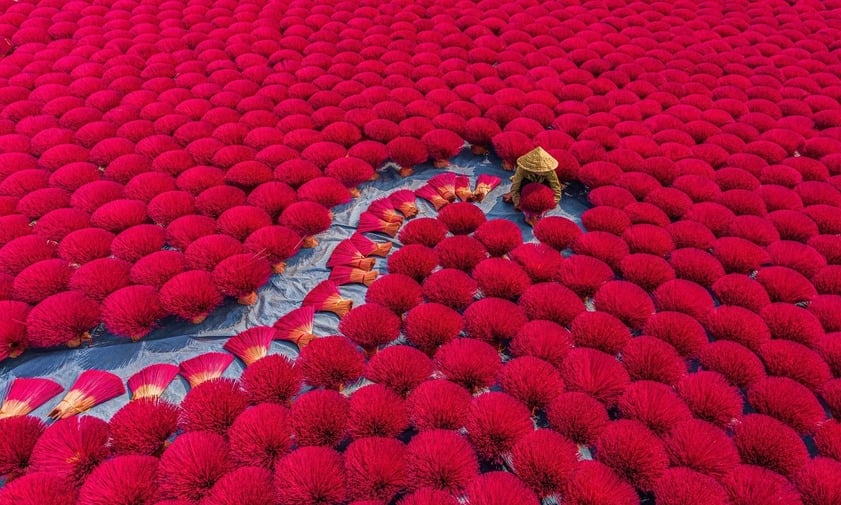
The incense-making process in Quang Phu Cau begins with basic steps like splitting bamboo, shaping the sticks, dyeing the tips, forming the stems, drying, and packaging. Each stage demands precision and effort, with the classification and dyeing of the incense sticks standing out as especially critical.
While the craft traditionally relied on manual labor, modern machinery has streamlined many processes, enhancing efficiency while preserving quality. The village comes alive in vibrant shades of red, a testament to its rich heritage. What truly sets Quang Phu Cau incense apart is its commitment to purity—eschewing chemical additives to ensure a product that is both safe and natural.
3. Renowned Hand Embroidery Craft Village in Hanoi – Quat Dong
- Address: Quat Dong Commune, Thuong Tin District, Hanoi
In its early days, the craft village of Quat Dong specialized in creating couplets, banners, and other items for communal houses and pagodas, as well as embroidering towels and court attire. Over time, the village expanded its offerings to include embroidered paintings, cushions, and clothing.
Each piece is meticulously crafted by skilled artisans, imbued with deep cultural and artistic significance. Today, Quat Dong’s exquisite embroidery is celebrated worldwide, with products exported to over 20 countries, including the United Kingdom, France, Thailand, Japan, and South Korea, showcasing Vietnam’s rich heritage on the global stage.
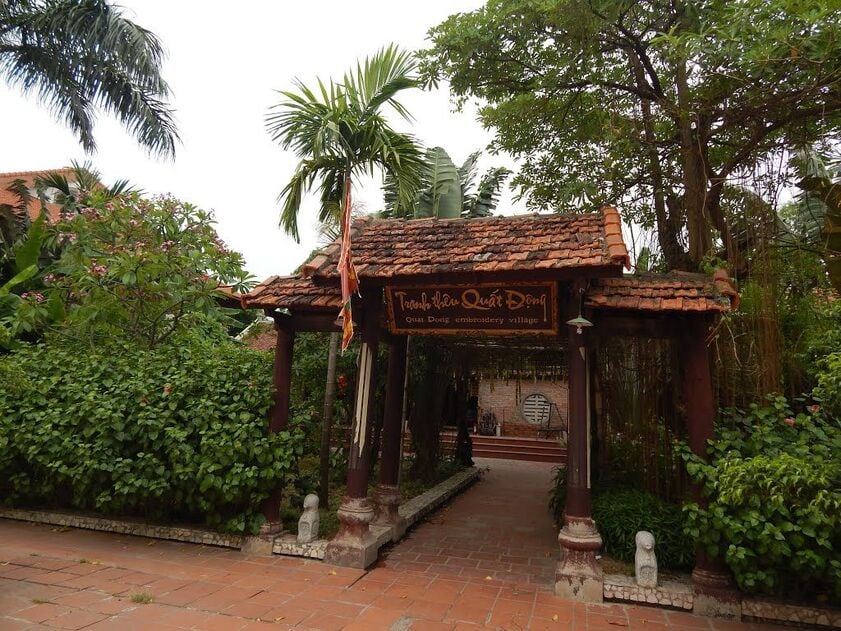
4. Bat Trang Ceramic Village
The name Bat Trang traces its roots to the Le dynasty, symbolizing the union of five renowned pottery lineages from the Bo Bat region in Thanh Hoa province with the Nguyen lineage from Minh Trang. These five prominent families—Tran, Vuong, Nguyen, Le, and Pham—joined forces and sent skilled artisans, pottery craftsmen, and their families to migrate to the Thang Long capital in search of new opportunities.
This migration laid the foundation for what would become the Bat Trang pottery village, renowned today for its enduring tradition of craftsmanship and artistry.
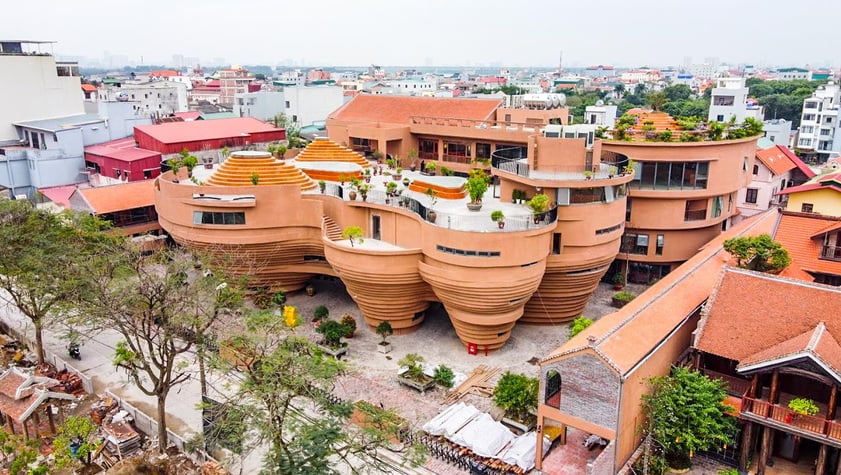
How to get to Bat Trang Ceramic Village:
By Bus: From Long Bien Transfer Station, travelers can take bus number 47 directly to Bat Trang Ceramic Village, which takes approximately 1.5 hours.
Private Transportation: From the center of Hanoi, cross the Chuong Duong Bridge and turn right following the Red River dike. When you see the sign for Bat Trang Ceramic Village, turn in that direction.
What to explore in Bat Trang:
- Communal House: Located by the riverbank.
- Ceramic Market: Discover large ceramic vases, statues, and flower pots in various sizes and colors. The market offers a wide range of unique ceramic products at reasonable prices—from bowls and cups to miniature landscapes and souvenirs.
- Pottery Making Experience: A hands-on activity for families, where visitors can shape their own pottery using clay and a potter’s wheel. It’s a fun way to learn about traditional craftsmanship and a chance to uncover hidden talents.
- Van Van Ancient House: One of Vietnam’s top 10 most beautiful ancient houses. Located at the edge of Bat Trang Village, it displays historic artifacts and serves as a simulated workshop for pottery-making.
5. Chang Son – Famous Fan Making Craft Village in Hanoi
- Address: Chang Son Commune, Thach That District, Hanoi
Chang Son Fan Village is a traditional craft village in Hanoi with a history spanning centuries. The fans produced here are known for their exceptional quality, distinctive shapes, and vibrant colors, crafted from materials like bamboo, fabric, silk, and paper.
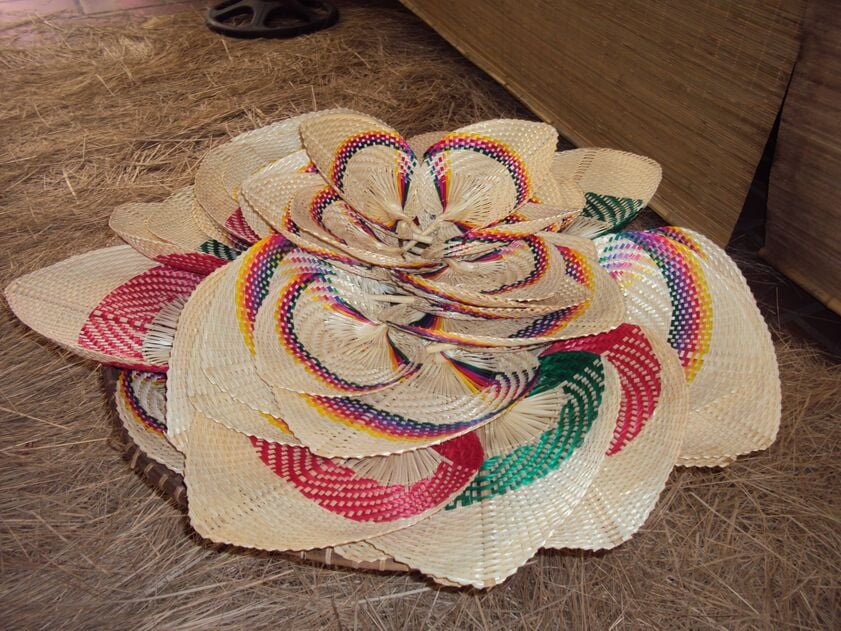
6. Phu Vinh Village – Bamboo Weaving Craft Village in Hanoi
- Address: Go Dau, Phu Nghia Commune, Chuong My District, Hanoi
Phu Vinh Bamboo Weaving Village is a prestigious craft village in Hanoi with roots dating back to the mid-17th century. Skilled artisans create distinctive and impressive bamboo products using traditional materials like bamboo, rattan, and sedge.
Phu Vinh’s bamboo weaving products are an integral part of daily life, found in items such as trays, baskets, furniture, cabinets, and artworks.
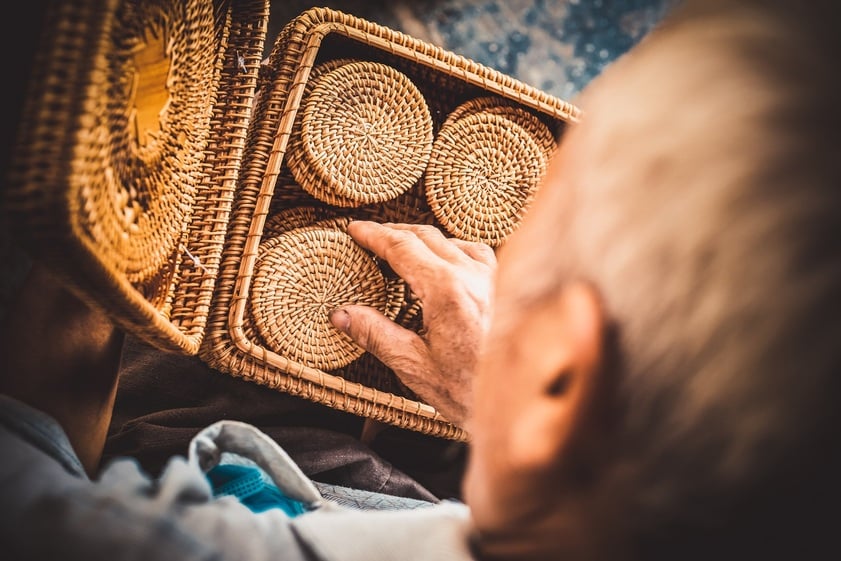
7. Van Phuc Silk Village, Ha Dong
Van Phuc Silk Village, also known as Hanoi’s Silk Village, is located along the banks of the Nhue River in Van Phuc Ward, Ha Dong District, about 10 km from the center of Hanoi. Originally named Van Bao, the village was renamed Van Phuc during the Nguyen dynasty. Van Phuc silk was a favored fabric for royal costumes, with enthusiasts ranging from King Khai Dinh to King Bao Dai. Historical documents suggest that silk weaving in this region dates back over a millennium, to the year 865 AD.

In the early 20th century, Van Phuc silk gained international recognition at the 1931 Marseille Fair in France and the 1932 Paris Fair, praised as an exquisite product of Indochina. Today, the village has over 1,000 weaving frames, with nearly 800 households involved in silk production, accounting for 60% of the village’s total. Adorned with ancient banyan trees, wells, and communal yards, Van Phuc Village maintains its traditional atmosphere. Despite its historical ups and downs, Van Phuc silk retains its sophisticated, skillful, and aesthetically rich features, embodying the elegance of a traditional craft village.
8. Conical Hat Village – Chuong My
Nestled beside the Day River, the Conical Hat Village is located in Phuong Trung Commune, Thanh Oai District, Hanoi. For over three centuries, it has been renowned for crafting conical hats, a staple of rural Vietnamese life. On market days, mothers and sisters gather near Chuong Pagoda to sell their unique handmade products. The market buzz and interactions create a sense of stepping back in time to the countryside of yesteryears, filled with emotions and hopes for a good harvest.
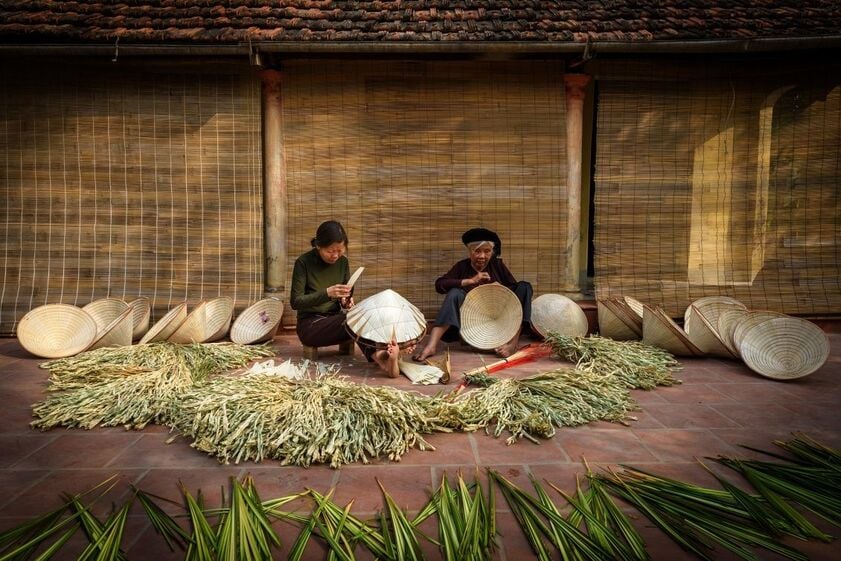
Visitors to the Conical Hat Village can see not just traditional conical hats but also variations like conical hats with straps, coconut leaf hats, and palm leaf hats—making it a place with one of the most diverse ranges of hats in Vietnam.
The image of Vietnamese women in traditional ao dai dresses adorned with conical hats has inspired countless poems and captivated those who appreciate Vietnamese culture both domestically and internationally. These simple and rustic conical hats represent an entire art form
9. Dao Thuc Village – Unique Water Puppetry Craft Village
- Address: Thuy Lam Commune, Dong Anh District, Hanoi
Water puppetry is a traditional folk art that has been practiced in Vietnam for around 300 years. To experience captivating performances steeped in the country’s history and culture, visit Dao Thuc Water Puppet Village. The skilled artisans perform smooth and graceful folk dance movements that promise to leave a lasting impression.
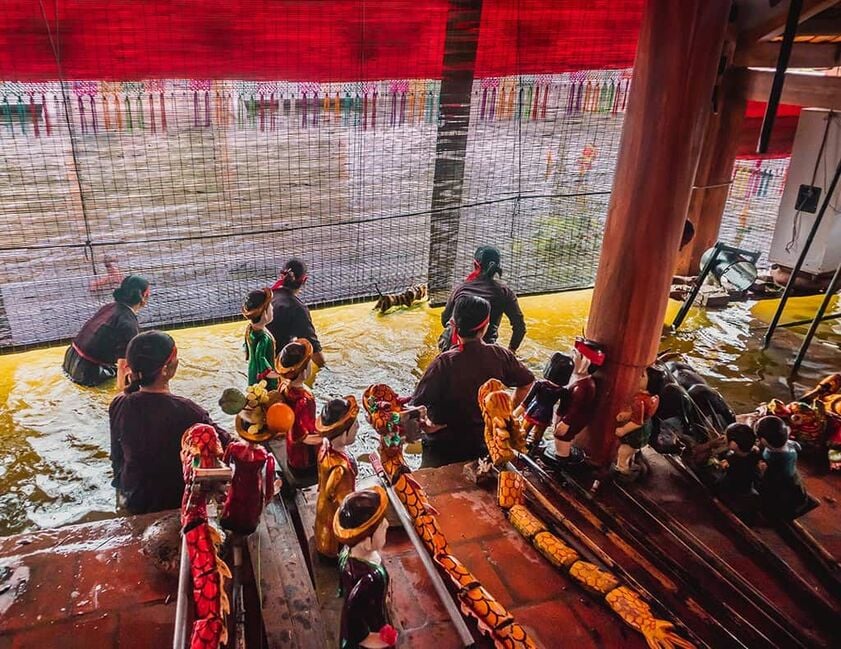
10. Cage making village Canh Hoạch
- Address: Canh Hoach Village, Dan Hoa Commune, Thanh Oai District, Hanoi
Canh Hoạch Village bird cages are internationally renowned, attracting buyers from abroad due to their durability, elegance, and variety of sizes and styles. Prices range from 500,000 VND to 1,500,000 VND on average.

Here’s a list of the top traditional craft villages in Hanoi with deep historical roots. If you get the chance, make sure to visit these destinations to experience the rich cultural beauty and essence of the nation

